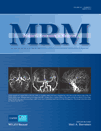MOXE: A model of gas exchange for hyperpolarized 129Xe magnetic resonance of the lung
Abstract
We present a model of gas exchange for hyperpolarized 129Xe in the lung, which we refer to as the Model of Xenon Exchange. The model consists of two expressions and characterizes uptake of dissolved xenon in the lung at two different resonance frequencies. The two expressions are governed by the following five critical pulmonary parameters that characterize both lung function and structure: the surface-area-to-volume ratio, barrier-to-septum ratio (ratio between air–blood barrier thickness and septal thickness), hematocrit, gas-exchange time constant, and pulmonary capillary transit time. The model is first validated by computer simulation. We show that Model of Xenon Exchange can be used to measure the pulmonary parameters mentioned above under various pathological or physiological conditions and is robust against moderate noise. Model of Xenon Exchange is further used to fit an existing data set of xenon uptake, thereby we demonstrate that the data can be well interpreted with Model of Xenon Exchange and reasonable parameters from the fitting routine. The good results obtained in both simulation and fitting to real data indicate that the model is sensitive to various functional and structural changes of the lung, and that it will allow for screening for a variety of pulmonary diseases by using hyperpolarized 129Xe of the lung. Magn Reson Med, 2013. © 2012 Wiley Periodicals, Inc.




